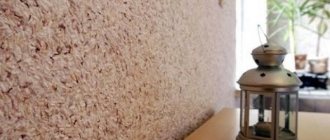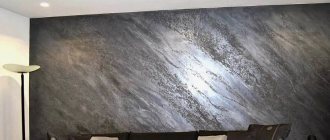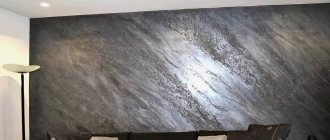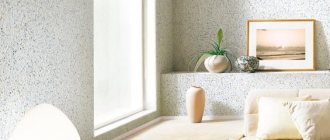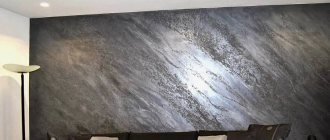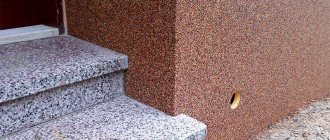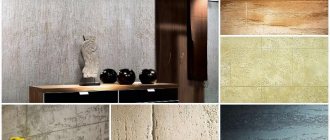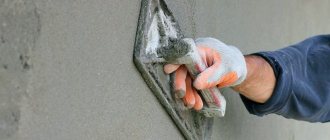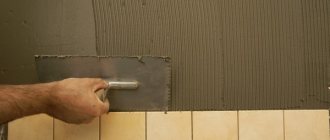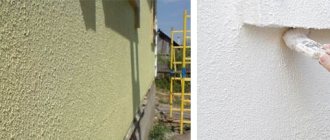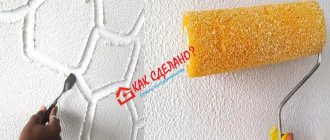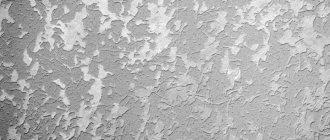Types of silk decorative plasters
One of the most sophisticated modern coatings is considered to be a coating that imitates a silk surface. If you look at it from different angles, you can observe a fantastic play of light, thanks to the mother-of-pearl fillers. Different designs create the illusion of translucency of the walls. All these effects are achieved by finishing the wall surface with a unique material - silk decorative plaster.
This miracle appeared on the building materials market in the 90s of the last century. Such plasters were imported from France, Turkey and even Japan. It was one of the most expensive and prestigious materials. However, something inexplicable happened. The demand for silk decorative plasters is not very high
This is because wealthier buyers were already fed up with this type of wall decoration and switched to newer ones, while less wealthy buyers did not dare to pay attention to this material, still believing that it was expensive. Although foreign manufacturers have long ago lowered the price level to $13 per 1 kg of the mixture, domestic manufacturers have long mastered the technology of its production and sell silk decorative plaster even cheaper - from $3 to $16 per 1 kg
Plasters of this type with the addition of artificial silk are widely represented on the building materials market by fairly well-known companies:
- "SILKOT" Japan;
- "Senedeco" France;
- "BAYRAMLAR" and "SILKOAT" Türkiye;
- “RODNIK-ART” and “PEACE TO YOUR HOME” Russia.
Silk plaster with artificial silk comes in different textures and compositions. Depending on these indicators, its price is calculated. It ranges from $2.5 to $25 per package, which can be used to plaster from 3m2 to 5m2.
Plasters with the addition of natural silk fibers are presented on the building materials market:
- FUDZIVARA CHEMICAL Co. Japan. These are 14 types of decorative silk plaster made in several colors. Such plasters are now quite rarely found on our market;
- "BAYRAMLAR" Türkiye. All wet silk decorative plasters produced by this company contain natural silk additives. Of course, this influences their high price points;
- “PEACE TO YOUR HOME” Russia. This manufacturer’s product range also includes one type of plaster with the addition of natural silk. The cost of one package of such plaster is about $9.
Preparatory activities for finishing with textured material
First of all, you need to decide what type of material you are going to work with, since it can be decorative plaster “wet silk”, “smooth silk” or “draped”. Before applying the material to the walls, you should consider their type (they can be concrete, brick, metal, wood, etc.)
Blue silk decorative plaster in the living room
If the walls are concrete and plastered, you should:
- assess their condition for the presence of peeling on the surface in order to eliminate them in order to apply the coating evenly;
- remove wallpaper (other decorative elements) present on the walls, treat, dry and prepare the surface for a new coating;
- To eliminate clearly visible stains on the walls, this can be done using a primer and light-colored paint.
When decorative plaster is applied to a metal surface, it also requires pre-treatment; it must be sanded, coated with oil paint or nitro enamel.
If the surfaces are wooden, then you will need to putty and prime them, and when applying “silk” to drywall, the entire sheet is puttied, not just the joints.
All that remains is to decide on the color of the material, because the range of silk plaster is diverse, it has more than a hundred varieties, from economical options to exclusive ones. Next, you need to prepare the necessary equipment and other available means for its dilution and subsequent application.
Silk liquid plaster in a modern interior
What is the material
There is a misconception that silk plaster and liquid wallpaper are the same material. This confusion is due to several reasons.
Firstly, both products can create a “silk” surface. But this is achieved in different ways. Thus, liquid wallpaper contains the main components in the form of silk or cellulose fibers. It is the components that ensure the desired result. Plaster acquires the desired effect due to the application technique.
Secondly, some manufacturers indicate that the plaster contains cellulose threads and silk particles. Yes, such substances are included in decorative mixtures, but they are not the main components, their content is insignificant.
In fact, silk decorative plaster includes particles of mother-of-pearl that have reflective capabilities (the rest of the components are standard). They are the ones who create overflows. To achieve this result, it is necessary to apply very thin layers, each of which will be no more than one millimeter. It should be noted that the number of layers can be from two to eight.
What is silk plaster
Liquid wallpaper and silk decorative plaster are the same material. Both the first and second names are considered correct. The second name is used to distinguish this particular type of wall covering from the range of liquid wallpaper. The only difference from ordinary liquid wallpaper is that wet silk plaster contains artificial silk fibers. Because of the silk filler, the wall covering is called nothing less than velvet plaster.
In addition to silk, the dry mixture contains water-soluble glue flakes, cotton fibers and cellulose. Various glitters and plasticizers are also added to the mixture.
Advantages and disadvantages
Decorative plaster has a lot of positive properties:
- Environmental friendliness. The material does not contain harmful substances that may have a negative impact on human health.
- Fire resistance. The mixture is not subject to combustion, therefore it is not a fire spreader. It also does not release toxic components when heated.
- Durability. The service life of such coating is tens of years. Excellent resistance to mechanical stress.
- Possibility of application to any surface. Indeed, the solution can be laid on different types of substrates.
It should be noted that there are also some disadvantages:
- High price. If we assume that lining 7 square meters (using a roller) requires 1 kg of mixture, then taking into account the number of layers it is not difficult to calculate the consumption and the final price.
- Difficulty performing the work. To get a truly amazing result you will have to make an effort. But this is a drawback of all decorative solutions.
- Difficulties of restoration. In fact, repairing a damaged area is quite simple, but the difficulty is that it is almost impossible to restore the desired effect. Especially if the coating has patterns or designs.
Prices and manufacturers
In fact, silk-look plaster appeared on domestic markets not so long ago. Therefore, not many people yet know what it is. Nevertheless, it is gaining great popularity. And all because modern manufacturers have learned to make it based on synthetic components, due to which this material has become much more accessible.
There are several manufacturers who have become leaders in the manufacture of such products:
- foreign brands - “Senedeco” (France), “Bayramlar” and “Silcoat” (Turkey), “Silcot” (Japan), “San Marco” (Italy).
- domestic brands – Silk Plaster and Optimist-Elite.
These plasters have a paste-like consistency that is very easy to work with. Even the “raw” mixture looks beautiful, having pearlescent tints.
As for prices, they start from 750 – 800 rubles per package. The main points are the manufacturer and place of purchase.
Advice. You should not look for cheap material, as this will affect the quality. In addition, it is recommended to purchase products at certified points of sale, where it is possible to ask for quality certificates.
Composition of plaster, areas of its application
Silk decorative plaster is used on fairly smooth surfaces; small defects are acceptable: the material is plastic, so it can hide minor cracks or smooth out curvature.
Noble decoration is appropriate both in an apartment or private house, and in official institutions. The coating will complement an elegant, strict or bold extravagant interior - its appearance depends on the components.
Silk plaster includes quartz chips to form a special structure. Among the producers of such finishing materials, French and Italian factories are the leaders - this is a product in a more expensive segment. The quality of goods from Turkey and products of some domestic brands is quite acceptable.
Each consumer can choose a dry or moistened type of material. The dry type will be convenient for moving and storing. It is preferred by those who are not sure about the timing of the start of repairs.
Wet silk decorative plaster is made with your own hands from liquid and dry components, which must be mixed according to the instructions. A rich color palette, special types - for example, with the addition of glitter or crumbs - will allow any consumer to choose the right option.
Application of decorative plaster
For application you will need the following tools and materials:
- Plaster is sold ready-made. Additionally, you can purchase colors.
- Trowel.
- Putty knife.
- Roller.
The technological process is as follows:
- The first layer is the base one; it will serve as the basis for further activities. It is applied in a thin layer. The work is done using a spatula and trowel. The mixture is collected in the required quantity and placed on a trowel. The tool is applied to the surface at a slight angle, movements should be smooth.
- The resulting surface is left for several hours. It should dry out enough. The exact timing indicators must be clarified in the manufacturer's instructions.
- The second layer is applied in the same order. But it must not be allowed to dry out, so the relief is formed immediately. The trowel is used to perform arc movements that create the required pattern. It is slightly smoothed.
Roller usage:
- The base layer is applied in the same way as in the first case.
- The subsequent layer is applied using a roller with a short question. They cover the required area. The mixture is laid without flaws, completely filling the selected space.
- Next, a trowel is used. They literally smooth the surface. The selected texture is formed with jerky movements.
Do not use a long-haired roller. It leaves behind a thick layer of material that is very difficult to process.
Creating a “velvet” surface
The work is carried out according to the following principle:
- The solution is applied in a layer that should not be too thin. This is because everything will be done in one step. The trowel must be used to make random strokes.
- Next, the necessary invoice is formed. The trowel is passed over the coating; movements should be jerky, without excessive pressure.
- The removed mixture will remain on the instrument. It is removed with a spatula.
- The entire area is processed, after which it is left until completely dry.
To get the result that was intended, you need to practice a little. The main thing is to understand the specifics of formation.
Flowing silk effect
Another commonly used application technique is called “flowing silk”. In this case, apply decorative silk plaster to the walls using diagonal movements. The process of preparation for application is completely identical, so we will omit its description.
- Base coat - apply the same mixture using a trowel, after application you must wait approximately 3 hours until it dries.
- Flowing silk - work is carried out as always in sections, apply the solution with a trowel and wait a short time until the top layer dries. Using diagonal movements of the trowel, create a pattern reminiscent of flowing silk fabric. Hold the tool at a slight angle to the surface.
Remember to use water to clean the surface of the tool while applying decorative silk.
Video. Creating flowing silk.
Advantages and disadvantages of wet silk coating
Like all decorative coatings, wet silk plaster has its pros and cons. As usual, let's start with the positive characteristics.
- Stylish design. The rich appearance of the coating with a mother-of-pearl sheen truly looks luxurious and unique.
- Possibility to choose any coating color down to the smallest shades. You can tint the material either yourself, manually using tinting paints, or automatically, which is more preferable to obtain a high-quality result.
- This is a seamless coating, which, unlike wallpapering walls, does not have unsightly joints.
- Can be used in any room, as the coating is environmentally friendly and waterproof.
- The wet silk coating is easy to keep clean - it can even be washed with a wet sponge, while the preservation of the original appearance is guaranteed by the manufacturers. It also allows the use of household chemicals and even solvents.
- If necessary, you can easily make minor repairs to individual surface fragments.
- Durability - manufacturers guarantee 20 years of impeccable service life.
Another advantage is attributed to this coating - ease of application, which, according to the manufacturers, can be done even by a novice repairman without experience. But it is not so. If you want to get a really high-quality result that will please you for many years, then it is better to invite a professional to apply the plaster.
Also, as an unreliable advantage, it is necessary to mention the absence of the need to prepare the surface for applying decorative plaster. Some resources convince us that there is no need to level the walls, eliminate potholes, cracks and chipped surfaces. However, this is also a very big misconception. It is always necessary to level the walls, and in our case this must be done with special care. After all, a perfectly flat wall is the key to a high-quality result.
The disadvantages include the high cost of this type of coating and the requirements for a perfectly flat base, which we just talked about. That's all. Instability to moisture, which is also often attributed to disadvantages, is not such, and the coating perfectly resists even direct exposure to moisture. Let us remind you that walls with this plaster can be washed with a wet sponge.
Some nuances
This material is very demanding on surface preparation. Although it can hide small cracks, other defects will be noticeable. Therefore, it is necessary to eliminate any shortcomings.
It is worth paying attention to some features:
- Avoid using products called fiberglass. It can damage the decorative layer. This is due to the fact that the material has good absorbency, which even a primer cannot level out.
- If metal beacons were used to apply the starting composition, they must be removed. Otherwise, there is a high probability that traces of corrosion will form.
- Walls in rooms characterized by high humidity are treated with moisture-resistant impregnations. Antiseptics are applied in advance, which should protect against fungus and mold.
Many manufacturers of silk-effect plaster recommend observing certain time intervals. Namely:
- block walls must withstand an interval of several months after the starting coating has been applied;
- for brick walls the period is up to six months;
- if the work was carried out in winter (in frozen rooms), then the decorative layer is laid only in summer.
Creating the effect of silk threads
“Silk threads” is a technique for applying decorative plaster, with the help of which a relief coating is obtained with long and thin vertical stripes across the entire surface. To create it, use the same acrylic plaster that is used for the “wet silk” coating.
For work you will need: the same tools + a decorating brush or a brush with stiff bristles.
Application technique:
- Prepare the base, apply a primer and leave until completely dry (12 hours).
- Cover the prepared surfaces with 1-2 layers of interior paint. Thanks to this, the hardening time of the plaster will increase, which will allow high-quality “threads” to be formed on the surface. Allow at least 2 hours between coats to allow the paint to dry.
- Acrylic plaster is thoroughly mixed and poured into a cuvette.
- The composition is applied using a fur paint roller. Layer thickness – up to 1 mm. If applied evenly, each square meter will require about 500 g of plaster. If they work alone and the surface area is large, treat 1 m² areas sequentially.
- While the material is not dry, use a plastic decorative brush to form the necessary relief. To do this, apply a brush to a wall covered with plaster, move it up and down, creating long vertical stripes.
- Before the solution hardens, you need to smooth the surface with a plastic spatula. During the process, excess composition will collect on its working edge; it must be removed with a clean rag.
- After the desired relief has been created on the surface, it is left to dry for 24 hours.
- Proceed to creating the finishing layer. Apply decorative varnish using a paint roller. While it is still wet, remove excess with a Venetian trowel. The pearlescent pigment penetrates into the recesses and is almost wiped off from the smooth surface, emphasizing the relief and enhancing the decorative effect. The varnish dries within 24 hours.
How to make “silk threads” in the interior yourself is shown in the next master class.
Silk-like decorative plaster is an elegant coating that is practical. Using various techniques, you can use it to decorate the walls of your kitchen, bedroom or living room in an original and stylish way.
Previous Decorative plaster “American” - a quick way of decorative plastering Next Decorative plaster Shagreen from plaster: cheap and quick wall finishing
Where and how to buy silk plaster
Silk plaster, created from alba decorative putty, is always available at our warehouse in Shchelkovo or at the plant in Voskresensk. Buying silk plaster is not difficult - you can place an order on our website or by phone, visit the sales office and pick it up yourself or order delivery to your address. We cooperate with cargo carriers and deliver any volume throughout Russia. You can arrange the delivery yourself or entrust it to our specialists. We also have a recommended tool in stock. You can buy silk plaster from us and learn how to apply it absolutely free, master class as a gift.
Surface preparation
Basic preparation is necessary for walls that have already been covered with decorative layers:
- The old coating is completely removed and the surface is cleaned of dirt and dust.
- The entire area is checked for hidden defects. The presence of voids and peeling areas should not be allowed.
- Restoration measures are carried out with acrylic putties.
- If painted surfaces cannot be completely cleaned, they are washed with water and greasy stains are removed. To create better adhesion, cover with numerous scratches. The glossy effect is removed with sandpaper.
- The primer is applied in two layers, each given time to dry completely.
Work is carried out at wall temperatures above 10 -15 degrees and air humidity no more than 80%.
Plaster application technique
If you have chosen this particular decorative product, then all that remains is to calculate and purchase the required quantity and move on to the most interesting part - applying it to the walls. Usually, the package with the dry mixture contains instructions that will make it easier for you to use this mixture.
But usually the instructions for preparing the mixture always remain the same:
- prepare a convenient container, such as a basin;
- pour into the container as much water as indicated on the package;
- add the glitter that comes with the plaster and stir thoroughly;
- Now you can add the main mixture itself and mix it thoroughly.
The composition is ready for use, and you can begin applying it immediately. Your actions will look like this:
- Primer. First prepare the base - this is necessary for better adhesion of the plaster to the working surface. Use an acrylic primer designed specifically for decorative compounds to increase adhesion. The primer is applied with a brush or roller, whichever is more convenient for you. The entire surface is covered with an even layer. Can be applied in several layers.
- First layer. Prepare a plastic trowel; it should be narrow or medium in size. Use it to scoop up a little of the finished plaster, apply it carefully to the surface, the strokes should be chaotic, the gaps should be minimal. For the first layer, a thickness of 2 mm is sufficient.
- Second layer. You cannot create a silk effect with one layer. A second layer is required! The application technique will be no different from applying the first layer. To simplify the task of creating texture, use different rollers to apply the composition.
You can use different application techniques to achieve an interesting silk plaster texture. For example, the “droppe” technique involves applying short strokes that are directed in different directions. You will get an interesting plexus of leaves and curls. There is also the “moon” technique, where the mixture is applied in long strokes. And to achieve maximum imitation of wet silk, you need to apply layers very thinly - no more than 1 mm. With special rollers you can “draw” complex patterns and create folds on the applied “fabric”.
Despite the high cost of the material, it is very popular, because it is an excellent replacement for the usual wallpaper. With silk plaster, the interior immediately becomes more noble and majestic. And if you compare it with the usual wall coverings made of paper or vinyl, the plaster will last you much longer. It will not fade in the sun and will not begin to peel off from the walls. Therefore, if you have the opportunity and desire to create an unusual interior at home or in the office, you can safely buy this particular biologically friendly finishing material.
How to apply: wall or ceiling application technique
Required Tools
Regardless of the methods of applying wet silk decorative plaster, you will need the following tools:
- Spatulas. Tools must have rounded edges. Such spatulas do not leave grooves on the wall or ceiling.
- Trowel. This instrument must be Venetian. Its size will depend on the surface area and pattern.
- Roller. An accessible tool that plays the role of an assistant at all stages of laying the surface layer.
- Containers for preparing the solution. This should be a basin that is used in construction and mixing mortars.
- Drill and mixing attachment. The tool is necessary for working with large volumes.
You also need to have protective gloves, a respirator, material for covering furniture, a bucket of water, small, medium and large rags, safety glasses and masking tape.
Pre-prepare the surface for work. This stage does not require meticulousness with this type of coating, since the texture of the composition hides all irregularities and inaccuracies after drying:
- Firstly, it is good to clean the wall or ceiling from peeling parts. The surface may remain uneven, but is smooth enough for application of the material.
- Secondly, remove any remaining dust or dirt on the surface. Use a soft cloth to go over all slopes and uneven areas. Dry the walls well if necessary.
Primer
For priming you will need to take a construction roller and a flat brush. These tools significantly speed up the processing of the base. The walls must be well prepared in advance: cleared of construction debris and dried.
Select a deep penetration primer taking into account the type of base. Depending on the surface on which the composition is intended to be applied, further manipulations are performed.
Walls can be:
- concrete;
- wooden;
- or from plasterboard.
For example, concrete bases absorb more primer than plasterboard. Wood can absorb one layer of primer, or it may require more extensive impregnation. It is better to take compounds with a penetrating ability of up to 1 cm. These compounds will level the structure of the base and strengthen the walls themselves.
A primer with quartz chips is optimal: it creates a rough crystalline lattice on the surface, which allows the decorative plaster to last as long as possible. Begin the treatment with a generous application of primer in one layer. When it dries, you can coat the walls a second time.
For dark surfaces it is good to have white primer on hand. Due to the white tint of the primer, there will be no distortion of the color of the wet silk that is applied to the base. The second layer takes longer to dry. But you need to get a dry surface before you can start working.
Base coat
The first layer of application is also called the base coat. This is the most important stage of work, which can be performed in several ways:
- The first method is to apply the composition with a large trowel. In this case, you do not need to create patterns, but simply let the layer dry well.
- You can apply a layer with a regular roller. This method is easy and does not require additional explanation.
- Third, paint is used as a base layer, which is rolled out with a medium-sized roller. The composition can vary to a different consistency, but the main thing is to leave the layer unchanged in structure. To do this, saturate the surface evenly, while helping with available tools.
- The base layer is the restraining base for the remaining layers. It is applied in a thin layer with a spatula and trowel. Tools should be at an angle, movements should be smooth and careful. After applying the first layer, the surface is left to dry for 2–3 hours.
Second layer
The second layer is applied in a similar manner to the first. But this layer should not be allowed to dry out, since the relief needs to be formed immediately:
- The trowel makes arc movements, which will create the main pattern. The resulting pattern should be slightly smoothed.
- If some mixtures require a one-time application of a layer over the entire surface to be treated, then wet silk plaster can be applied in stages. The edges of the area are left with unevenness.
- The mixture layer is applied with a short-nap roller. The required area is completely covered with a non-uniform layer of the mixture. It should fit without flaws and completely fill the space.
- Then take a trowel to smooth the surface. This is done with jerky movements, which form the selected texture.
You cannot use a roller with long pile for work, as it absorbs a thick layer of the composition, which is then very difficult to distribute along the desired path.
To create a velvet surface you need:
- Apply the solution in a not very thin layer, and use a trowel to make movements in the form of random strokes.
- Then you can begin to create the required texture. They go over the coating with a trowel again, but this time not with chaotic, but with jerky movements without strong pressure on the wall or ceiling. The trowel will constantly clean off excess layers, which are removed with a medium-sized spatula.
Painting and final stage
A middle layer of plaster is applied to the trowel and a neat stroke is made from the junction of the wall and the ceiling. The corners of the walls are processed with slow movements both horizontally and vertically. Apply the composition in a very thin layer, then spread it well around the perimeter of the required area of painting.
Stages of work:
- First, the joint along the wall and ceiling is plastered. Then they move to another area and gradually follow the square along the junction of the walls just below the previous one.
- Return to the top of the wall. After applying the coating to the entire planned surface, the mixture is allowed to dry thoroughly.
- The second layer is applied in the same sequence.
- When the next square is completed, you need to return to the plastered area in front of it. On a dried, but not completely dry surface, sweep the trowel across the entire wall with chaotic movements. The result will be an iridescent silk pattern, which can be aligned in some parts at your discretion.
- After the second layer has dried, the wall is polished or ironed. The tool is used to work on a slightly set surface and smooth out the smallest roughness.
- Polish the coating with a clean trowel or trowel, repeating the same movements used to apply the 2nd layer. When polishing, you need to apply a little force to achieve a clearly visible gloss.
Silk plaster Silk Plaster - what are its features and advantages
A very popular material in this category today is silk plaster. These liquid wallpapers are made from environmentally friendly materials, especially silk fiber and cellulose, which allows them to be used in all rooms. Using Silk Plaster allows you to obtain a reliable, seamless silk coating that is resistant to fluctuations in temperature and humidity, does not absorb odors, is not afraid of ultraviolet radiation, and effectively hides all defects of uneven walls.
If you want silk that is easy to apply and doesn't cause any discomfort, Silk Plaster is a great solution. It has no pungent odors, and if it gets on other surfaces, including floors and furniture, it can be easily wiped off without leaving a trace. It is worth noting that even in the process of applying it to the wall, there is a lot of time left to correct flaws or even completely remove silk liquid wallpaper from the wall before it dries, if you did something wrong.
Thus, Silk Plaster silk plaster is perfect for decorating any premises, without creating additional difficulties in design, and at the same time, allowing you to get an original and attractive interior.
Cost of silk plaster
The cost of silk plaster is calculated based on your square footage, the required color and the effect to be recreated. The larger the area, the lower the cost per square meter of silk plaster will be. Initially, you need to calculate the required volume. To do this, multiply the consumption by the number of square meters. Consumption of Uno-decor color substrate is 160 grams per m2, Alba decorative putty is an average of 250 g/m2. For example, you need to decorate a room with a wall area of 40 m2, let’s take color 050 (silver):
- Uno Decor – 160g x 40m2 = 6.4kg. Let’s take a bucket with a volume of 7 kg, price – 2700 rubles
- Alba – 250g x 40m2 = 10kg. 2 buckets of 5 kg each, the price of a bucket in this color is 8500 rubles, x2 = 17000 rubles
In total, we get the cost of silk plaster in silver color for 40 square meters - 19,700 rubles, and the price of silk plaster per m2 - 19,700/40 = 492.5 rubles, which is quite affordable for an environmentally friendly product produced on German equipment using only imported components . European quality standard at an affordable price.
Paint "Uno Decor"
- Buy Paint “Uno Decor”
Alba putty
- Buy Putty “Alba”
Varnish "Masco Riflessi"
